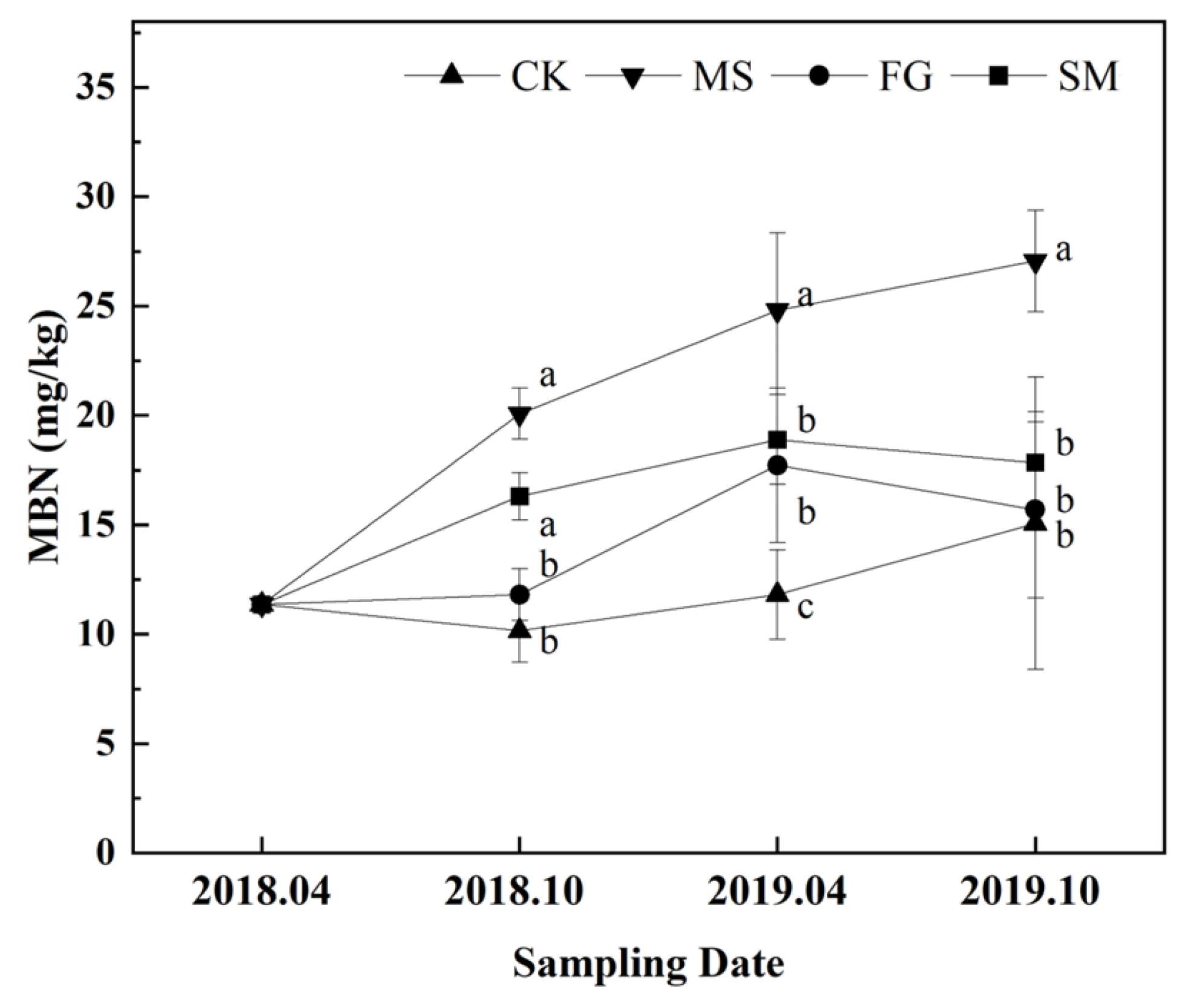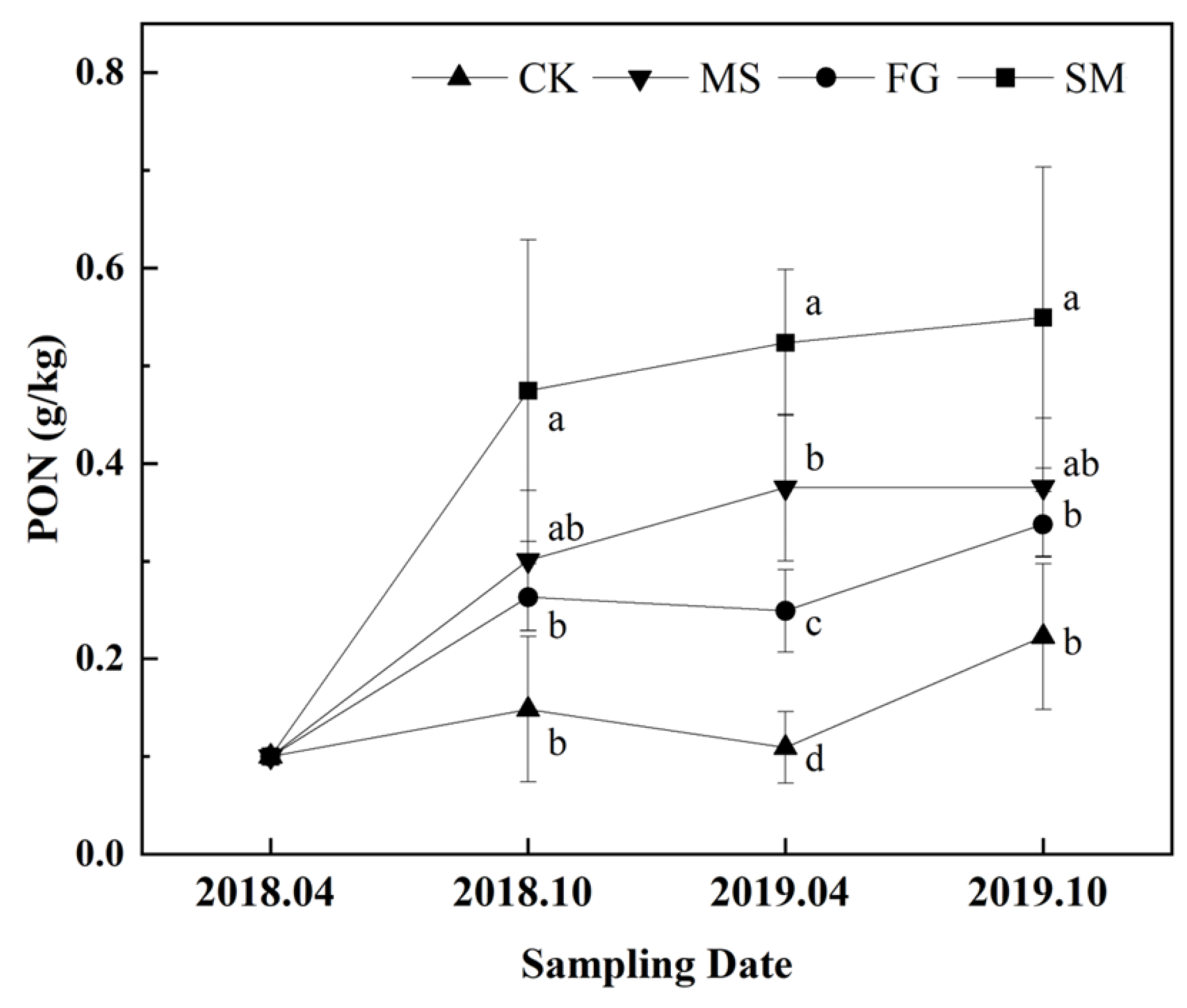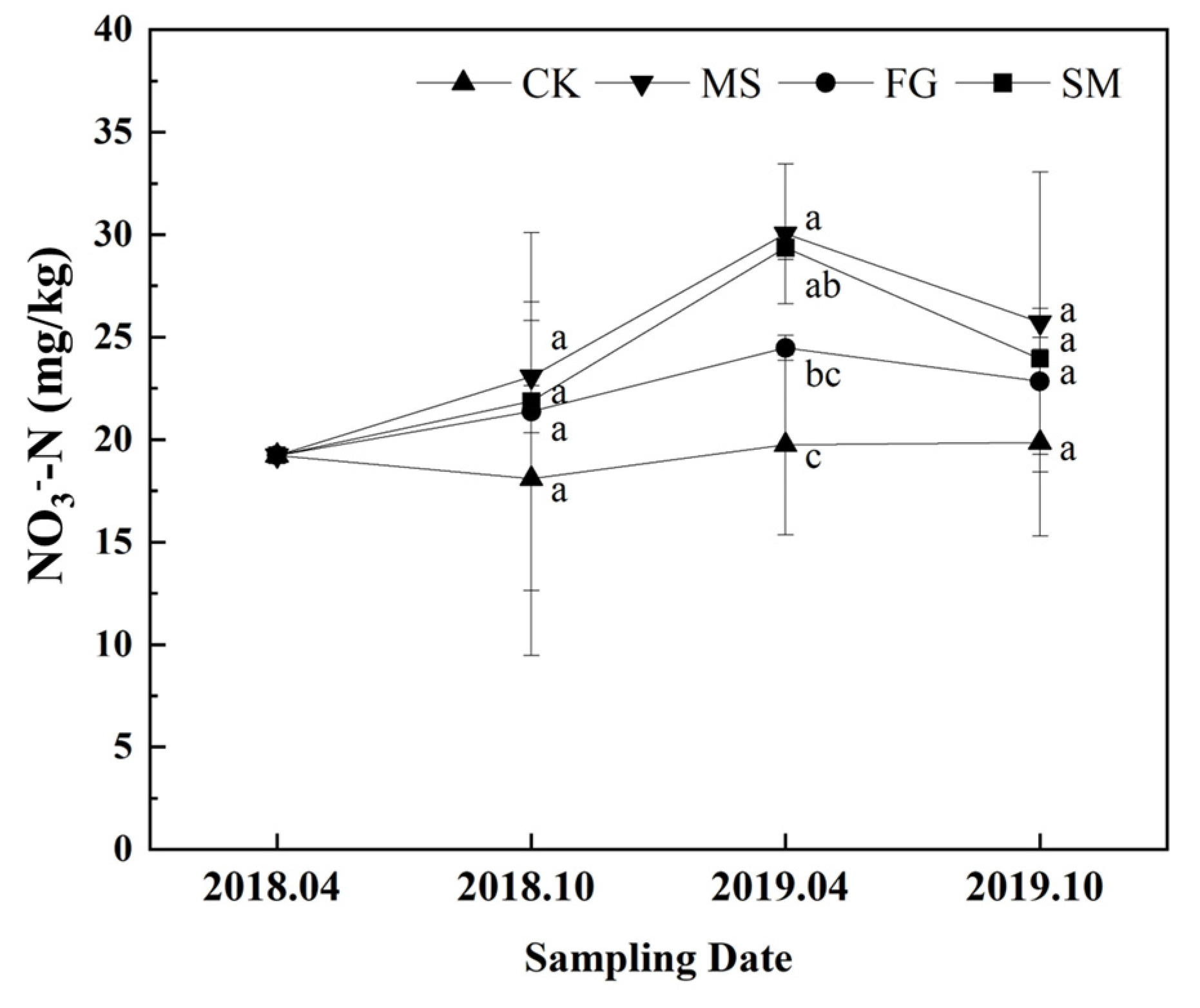Returning Different Organic Materials to the Field: Effects on Labile Soil Nitrogen Pool under Drip Irrigation with Film Mulching in a Semi-Arid Soil
Abstract
1. Introduction
2. Materials and Methods
2.1. Experimental Site
2.2. Experimental Design
2.3. Soil Sampling
2.4. Determination of Soil Nutrient Content
2.5. Statistical Analyses
3. Results
3.1. Effects of Different Organic Materials on Soil TN Content
3.2. Effects of Different Organic Materials on Soil DON Content
3.3. Effects of Different Organic Materials on Soil MBN Content
3.4. Effects of Different Organic Materials on Soil PON Content
3.5. Effects of Different Organic Materials on Soil ATN Content
3.6. Effects of Different Organic Materials on Soil NH4+-N, NO3−-N, and Nmin Content
3.7. Distribution Ratio and Correlations of Soil Active Nitrogen Fractions
4. Discussion
5. Conclusions
Author Contributions
Funding
Institutional Review Board Statement
Informed Consent Statement
Data Availability Statement
Acknowledgments
Conflicts of Interest
References
- Ren, C.C.; Zhang, X.M.; Reis, S.; Wang, J.X.; Xu, J.M.; Gu, B.J. Climate change unequally affects nitrogen use and losses in global croplands. Nat. Food 2023, 4, 294–304. [Google Scholar] [CrossRef] [PubMed]
- Liang, C. Nitrogen fertilization mitigates global food insecurity by increasing cereal yield and its stability. Glob. Food Secur. 2022, 34, 100652. [Google Scholar] [CrossRef]
- Litskas, V.D. Environmental impact assessment for animal waste, organic and synthetic fertilizers. Nitrogen 2023, 4, 16–25. [Google Scholar] [CrossRef]
- Wang, H.X.; Xu, J.L.; Sheng, L.X.; Zhang, D.; Li, L.W.; Wang, A.X. Study on the pollution status and control measures for the livestock and poultry breeding industry in northeastern China. Environ. Sci. Pollut. Res. 2018, 25, 4435–4445. [Google Scholar] [CrossRef] [PubMed]
- Wang, H.X.; Xu, J.L.; Sheng, L.X. Study on the comprehensive utilization of resources city kitchen waste in China. Energy 2019, 173, 263–277. [Google Scholar] [CrossRef]
- Li, C.X.; Ma, S.C.; Shao, Y.; Ma, S.T.; Zhang, L.L. Effects of long-term organic fertilization on soil microbiologic characteristics, yield and sustainable production of winter wheat. J. Integr. Agric. 2018, 17, 210–219. [Google Scholar] [CrossRef]
- Panico, S.C.; Memoli, V.; Napoletano, P.; Esposito, F.; Colombo, C.; Maisto, G.; De Marco, A. Variation of the chemical and biological properties of a Technosol during seven years after a single application of compost. Appl. Soil Ecol. 2019, 138, 156–159. [Google Scholar] [CrossRef]
- Liu, X.Q.; Liu, H.G.; Zhang, Y.S.; Liu, C.R.; Liu, Y.N.; Li, Z.H.; Zhang, M.C. Organic amendments alter microbiota assembly to stimulate soil metabolism for improving soil quality in wheat-maize rotation system. J. Environ. Manag. 2023, 339, 117927. [Google Scholar] [CrossRef]
- Zhang, X.B.; Xu, M.G.; Liu, J.; Sun, N.; Wang, B.R.; Wu, L. Greenhouse gas emissions and stocks of soil carbon and nitrogen from a 20-year fertilized wheat-maize intercropping system: A model approach. J. Environ. Manag. 2016, 167, 105–114. [Google Scholar] [CrossRef]
- Shaji, H.; Chandran, V.; Mathew, L. Organic fertilizers as a route to controlled release of nutrients. In Controlled Release Fertilizers for Sustainable Agriculture; Academic Press: Cambridge, MA, USA, 2021; pp. 231–245. [Google Scholar]
- Haynes, R.J. Labile organic matter fractions as central components of the quality of agricultural soils: An overview. Adv. Agron. 2005, 85, 221–268. [Google Scholar]
- Wang, L.; Li, M. Review of soil dissolved organic nitrogen cycling: Implication for groundwater nitrogen contamination. J. Hazard. Mater. 2023, 461, 132713. [Google Scholar] [CrossRef] [PubMed]
- Ma, X.; Han, F.; Wu, J.; Ma, Y.; Jacoby, P. Optimizing crop water productivity and altering root distribution of Chardonnay grapevine (Vitis vinifera L.) in a silt loam soil through direct root-zone deficit irrigation. Agric. Water Manag. 2023, 277, 108072. [Google Scholar] [CrossRef]
- Hu, J.; Wu, J.; Qu, X. Decomposition characteristics of organic materials and their effects on labile and recalcitrant organic carbon fractions in a semi-arid soil under plastic mulch and drip irrigation. J. Arid. Land 2018, 10, 115–128. [Google Scholar] [CrossRef]
- Cambardella, C.A.; Elliott, E.T. Particulate soil organic-matter changes across a grassland cultivation sequence. Soil Sci. Soc. Am. J. 1992, 56, 777–783. [Google Scholar] [CrossRef]
- Vance, E.D.; Brookes, P.C.; Jenkinson, D.S. An extraction method for measuring soil microbial biomass C. Soil Biol. Biochem. 1987, 19, 703–707. [Google Scholar] [CrossRef]
- Jones, D.; Willett, V. Experimental evaluation of methods to quantify dissolved organic nitrogen (DON) and dissolved organic carbon (DOC) in soil. Soil Biol. Biochem. 2006, 38, 991–999. [Google Scholar] [CrossRef]
- Zhou, Y.; Chu, K.J.; Su, H.L. Effects of agronomic measures on soil dissolved organic matter: A review. Soil 2022, 54, 437–445. [Google Scholar]
- Stewart, C.E.; Paustian, K.; Conant, R.T.; Plante, A.F.; Six, J. Soil carbon saturation: Implications for measurable carbon pool dynamics in long-term incubations. Soil Biol. Biochem. 2009, 41, 357–366. [Google Scholar] [CrossRef]
- Li, P.; Li, Y.B.; Zhang, H.J.; Shen, X.S. Crop yield-soil quality balance in double cropping in China’s upland by organic amendments: A meta-analysis. Geoderma 2020, 5, 115197. [Google Scholar] [CrossRef]
- Wei, H.; Zhang, K.; Zhang, J.E.; Li, D.F.; Zhang, Y.; Xiang, H.M. Grass cultivation alters soil organic carbon fractions in a subtropical orchard of southern China. Soil Tillage Res. 2018, 181, 110–116. [Google Scholar] [CrossRef]
- Zhou, L.M.; Jin, S.L.; Liu, C.A.; Xiong, Y.C.; Si, J.T.; Li, X.G.; Gan, Y.T.; Li, F.M. Ridge-furrow and plastic-mulching tillage enhances maize-soil interactions: Opportunities and challenges in a semiarid agroecosystem. Field Crops Res. 2012, 126, 181–188. [Google Scholar] [CrossRef]
- Herrmann, A.; Witter, E. Sources of C and N contributing to the flush in mineralization upon freeze-thaw cycles in soils. Soil Biol. Biochem. 2022, 34, 1495–1505. [Google Scholar] [CrossRef]
- Zong, R.; Wang, Z.; Li, W.; Li, H.; Ayantobo, O.O. Effects of practicing long-term mulched drip irrigation on soil quality in Northwest China. Sci. Total Environ. 2023, 878, 163247. [Google Scholar] [CrossRef] [PubMed]
- -Guo, P.; Kong, D.; Yang, L. Differences in characteristics of sample sites explain variable responses of soil microbial biomass to nitrogen addition: A meta-analysis. Ecosystems 2023, 26, 1703–1715. [Google Scholar] [CrossRef]
- Powlson, D.; Brookes, P.; Christensen, B. Measurement of soil microbial biomass provides an early indication of changes in total soil organic matter due to straw incorporation. Soil Biol. Biochem. 1987, 19, 159–164. [Google Scholar] [CrossRef]
- Luo, S.; Zhu, L.; Liu, J.; Bu, L.; Yue, S.; Shen, Y.; Li, S. Mulching effects of labile soil organic nitrogen pools under a spring maize cropping system in semiarid farmland. Agron. J. 2015, 107, 1465–1472. [Google Scholar] [CrossRef]
- Christensen, S.; Christensen, B.T. Organic matter available for denitrification in different soil fractions: Effect of freeze /thaw cycles and straw disposal. Eur. J. Soil Sci. 1991, 42, 637–647. [Google Scholar] [CrossRef]
- Xie, H.; Li, J.; Zhu, P.; Peng, C.; Wang, J.; He, H.; Zhang, X. Long-term manure amendments enhance neutral sugar accumulation in bulk soil and particulate organic matter in a Mollisol. Soil Biol. Biochem. 2014, 78, 45–53. [Google Scholar] [CrossRef]
- Yao, Z.; Xu, Q.; Chen, Y. Leguminous green manure enhances the soil organic nitrogen pool of cropland via disproportionate increase of nitrogen in particulate organic matter fractions. Catena 2021, 207, 105574. [Google Scholar] [CrossRef]
- Sainju, U.M.; Lenssen, A.W. Dryland soil carbon dynamics under alfalfa and durum-forage cropping sequences. Soil Tillage Res. 2011, 13, 30–37. [Google Scholar] [CrossRef]
- Ichihashi, Y.; Date, Y.; Shino, A. Multi-omics analysis on an agroecosystem reveals the significant role of organic nitrogen to increase agricultural crop yield. Proc. Natl. Acad. Sci. USA 2020, 117, 14552–14560. [Google Scholar] [CrossRef] [PubMed]
- Mao, H.L.; Fu, X.; Zhao, D.D.; Li, R.R.; Wang, J. Seasonal dynamics of soil nitrogen fractions in dryland spring maize field under straw and plastic film mulching. J. Soil Water Conserv. 2018, 32, 246–254. [Google Scholar]
- Deluca, T.H.; Mackenzie, M.D.; Gundale, M.J.; Holben, W.E. Wildfire-produced charcoal directly influences nitrogen cycling in ponderosa pine forests. Soil Sci. Soc. Am. J. 2006, 70, 448–453. [Google Scholar] [CrossRef]
- Luo, Y.; Durenkamp, M.; De Nobili, M.; Lin, Q.; Brookes, P.C. Short term soil priming effects and the mineralization of biochar following its incorporation to soils of different pH. Soil Biol. Biochem. 2011, 43, 2304–2314. [Google Scholar] [CrossRef]
- Ball, P.N.; Mackenzie, M.D.; Deluca, T.H.; Holben, W.E. Wildfire and charcoal enhance nitrification and ammonium-oxidizing bacterial abundance in dry montane forest soils. J. Environ. Qual. 2010, 39, 1243–1253. [Google Scholar] [CrossRef] [PubMed]
- Jing, Y.; Chen, X.M.; Li, Q.X.; Huang, Q.R.; Zhang, J.B.; Chen, C.; Lu, S.S. Effects of biochar on ammonium nitrogen and nitrate nitrogen in red soil. J. Soil Water Conserv. 2013, 27, 265–269. [Google Scholar]
- Li, X.M.; Chen, Q.L.; Shi, Q.; Chen, S.C.; Reid, B.J. Organic carbon amendments affect the chemodiversity of soil dissolved organic matter and its associations with soil microbial communities. Environ. Sci. Technol. 2018, 53, 50–59. [Google Scholar] [CrossRef] [PubMed]
- Nelissen, V.; Rütting, T.; Huygens, D.; Staelens, J.; Ruysschaert, G.; Boeckx, P. Maize biochars accelerate short-term soil nitrogen dynamics in a loamy sand soil. Soil Biol. Biochem. 2012, 55, 20–27. [Google Scholar] [CrossRef]
- Hardy, J.P.; Groffman, P.M.; Fitzhugh, R.D.; Henry, K.S.; Welman, A.T.; Demers, J.D.; Fahey, T.J.; Driscoll, C.T.; Tierney, G.L.; Nolan, S. Snow depth manipulation and its influence on soil frost and water dynamics in a northern hardwood forest. Biogeochemistry 2001, 56, 151–174. [Google Scholar] [CrossRef]
- Groffman, P.M.; Hardy, J.P.; Driscoll, C.T.; Fahey, T.J. Snow depth, soil freezing, and fluxes of carbon dioxide, nitrous oxide and methane in a northern hardwood forest. Glob. Change Biol. 2006, 12, 1748–1760. [Google Scholar] [CrossRef]
- Wu, J.J.; Zhang, H.; Pan, Y.T.; Cheng, X.L.; Zhang, K.R.; Liu, G.H. Particulate organic carbon is more sensitive to nitrogen addition than mineral-associated organic carbon: A meta-analysis. Soil Tillage Res. 2023, 8, 105770. [Google Scholar] [CrossRef]








| MS | FG | SM | |
|---|---|---|---|
| Organic C (g kg−1) | 430.46 ± 70.37 a | 346.29 ± 18.39 ab | 272.95 ± 19.07 b |
| Total N (g kg−1) | 6.25 ± 1.02 c | 16.79 ± 0.89 a | 9.73 ± 0.74 b |
| C:N ratio | 68.89 ± 0.03 a | 20.63 ± 0.02 c | 28.09 ± 0.18 b |
| Lignin (%) | 4.02 ± 0.66 a | 3.23 ± 0.17 ab | 2.55 ± 0.18 b |
| Cellulose (%) | 25.52 ± 1.35 ab | 31.72 ± 5.19 a | 20.12 ± 1.41 b |
| Sampling Date | Treatment | MBN/TN | DON/TN | PON/TN | ATN/TN | Nmin/TN |
|---|---|---|---|---|---|---|
| October 2018 | SM | 1.17 ± 0.08 b | 0.74 ± 0.29 a | 33.98 ± 6.23 a | 35.89 ± 6.34 a | 1.86 ± 0.09 a |
| FG | 0.98 ± 0.11 b | 0.94 ± 0.04 a | 21.77 ± 1.43 ab | 23.69 ± 1.30 ab | 2.12 ± 0.37 a | |
| CK | 0.88 ± 0.13 b | 0.71 ± 0.26 a | 12.86 ± 3.60 b | 14.45 ± 3.69 b | 2.20 ± 0.41 a | |
| MS | 1.56 ± 0.14 a | 0.89 ± 0.12 a | 23.07 ± 2.61 ab | 25.52 ± 2.63 ab | 2.03 ± 0.23 a | |
| April 2019 | SM | 1.39 ± 0.07 b | 0.57 ± 0.18 a | 38.34 ± 2.13 a | 40.60 ± 2.11 a | 3.35 ± 0.21 a |
| FG | 1.36 ± 0.14 b | 0.64 ± 0.34 a | 19.19 ± 1.91 c | 21.19 ± 1.97 c | 3.12 ± 0.37 a | |
| CK | 0.98 ± 0.13 b | 0.33 ± 0.09 a | 8.95 ± 1.50 d | 10.27 ± 1.49 d | 2.98 ± 0.18 a | |
| MS | 1.87 ± 0.15 a | 0.71 ± 0.11 a | 28.36 ± 3.46 b | 30.94 ± 3.44 b | 3.15 ± 0.04 a | |
| October 2019 | SM | 1.28 ± 0.14 a | 0.78 ± 0.05 ab | 39.66 ± 7.23 a | 41.72 ± 7.37 a | 2.41 ± 0.13 a |
| FG | 1.30 ± 0.22 a | 0.90 ± 0.06 a | 27.70 ± 1.36 ab | 29.90 ± 1.18 ab | 2.85 ± 0.16 a | |
| CK | 1.30 ± 0.35 a | 0.70 ± 0.01 b | 19.10 ± 3.99 b | 21.10 ± 4.28 b | 2.78 ± 0.18 a | |
| MS | 2.00 ± 0.08 a | 0.84 ± 0.07 ab | 27.74 ± 2.63 ab | 30.58 ± 2.57 ab | 2.61 ± 0.35 a |
| TN | MBN | DON | PON | ATN | NO3−-N | NH4+-N | Nmin | |
|---|---|---|---|---|---|---|---|---|
| TN | 1 | 0.669 * | 0.357 | 0.868 ** | 0.872 ** | 0.683 * | −0.073 | 0.317 |
| MBN | 1 | 0.395 | 0.5532 | 0.547 | 0.791 ** | 0.047 | 0.459 | |
| DON | 1 | 0.514 | 0.527 | 0.205 | −0.701 * | −0.382 | ||
| PON | 1 | 1.000 ** | 0.658 * | −0.111 | 0.276 | |||
| ATN | 1 | 0.663 * | −0.121 | 0.272 | ||||
| NO3−-N | 1 | 0.287 | 0.740 ** | |||||
| NH4+-N | 1 | 0.857 ** | ||||||
| Nmin | 1 |
Disclaimer/Publisher’s Note: The statements, opinions and data contained in all publications are solely those of the individual author(s) and contributor(s) and not of MDPI and/or the editor(s). MDPI and/or the editor(s) disclaim responsibility for any injury to people or property resulting from any ideas, methods, instructions or products referred to in the content. |
© 2024 by the authors. Licensee MDPI, Basel, Switzerland. This article is an open access article distributed under the terms and conditions of the Creative Commons Attribution (CC BY) license (https://creativecommons.org/licenses/by/4.0/).
Share and Cite
Cheng, W.; Ma, X.; Wu, J.; Gu, Y.; Duo, X. Returning Different Organic Materials to the Field: Effects on Labile Soil Nitrogen Pool under Drip Irrigation with Film Mulching in a Semi-Arid Soil. Appl. Sci. 2024, 14, 2818. https://doi.org/10.3390/app14072818
Cheng W, Ma X, Wu J, Gu Y, Duo X. Returning Different Organic Materials to the Field: Effects on Labile Soil Nitrogen Pool under Drip Irrigation with Film Mulching in a Semi-Arid Soil. Applied Sciences. 2024; 14(7):2818. https://doi.org/10.3390/app14072818
Chicago/Turabian StyleCheng, Wei, Xiaochi Ma, Jinggui Wu, Yue Gu, and Xinqu Duo. 2024. "Returning Different Organic Materials to the Field: Effects on Labile Soil Nitrogen Pool under Drip Irrigation with Film Mulching in a Semi-Arid Soil" Applied Sciences 14, no. 7: 2818. https://doi.org/10.3390/app14072818
APA StyleCheng, W., Ma, X., Wu, J., Gu, Y., & Duo, X. (2024). Returning Different Organic Materials to the Field: Effects on Labile Soil Nitrogen Pool under Drip Irrigation with Film Mulching in a Semi-Arid Soil. Applied Sciences, 14(7), 2818. https://doi.org/10.3390/app14072818






